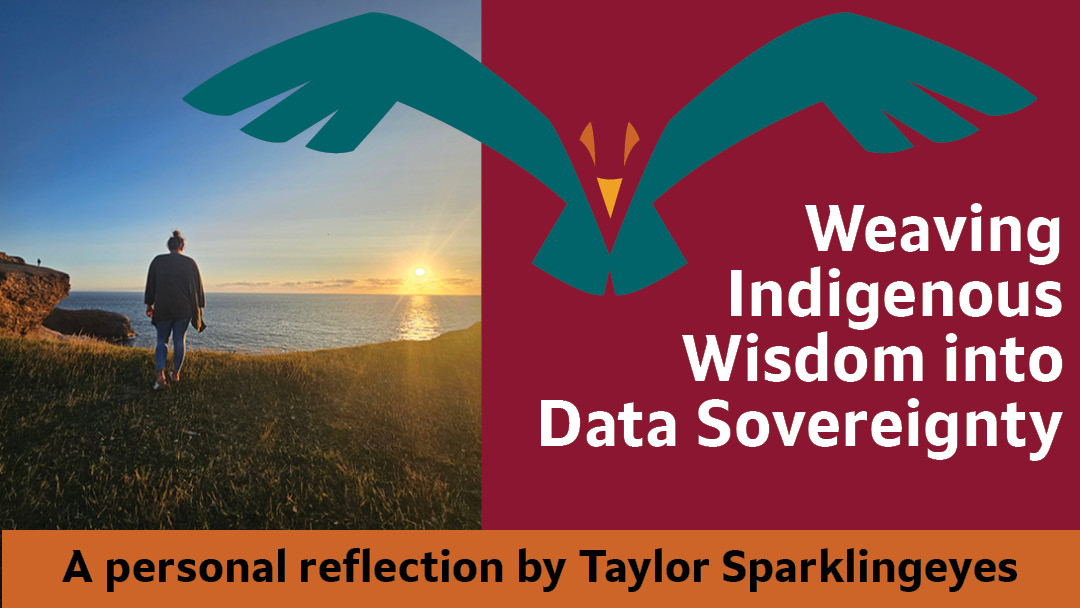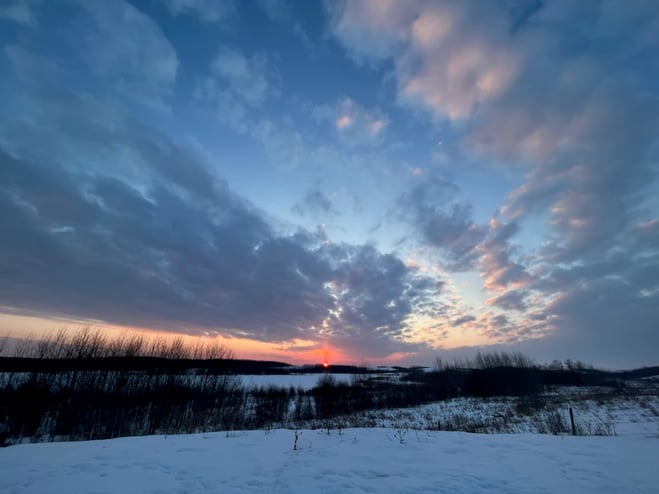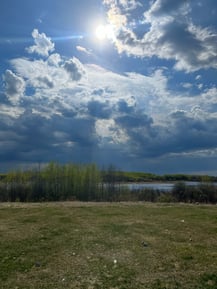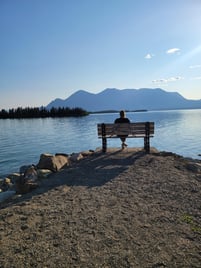
"We need to do better as external researchers when working with Indigenous communities to ensure their voices and stories can be told in the way they want them to be told and shared. "
My Indigenous Lens
Growing up, I remember sitting down and listening to my grandmothers, aunties, and uncles sharing stories of the lands, the waters, and our community of Goodfish Lake First Nation. As a little girl I was taught to sit and listen when Elders spoke and shared their stories. Indigenous Peoples have always shared our customs, values, and traditions through stories. Our histories and experiences have been passed down through generations this way as well. These stories arose from my ancestors' understanding of Mother Earth, lands, waters, governance, and structure, and have guided our peoples’ decisions and ways of life.
As I listened to these stories, I began to understand that behind them were bits and pieces of data. All these stories had a teaching and human experience embedded within them. Our voices, our stories, have always been how we have shared and collectively understood data.
The teachings, the stories, and the listening I have gathered over my lifetime have all been forms of data that continue to help me navigate and understand the world.
My Taught Lens
I grew up and attended school in a small rural Albertan community. I was taught by my teachers that data was made up of numbers and information about a specific issue or topic. Data in school was taught through qualitative and quantitative methods. I was taught that data needed to fit into these distinct categories for it to be logical and factual.
Schools teach us that data is a numerical or categorical feature to better understand a specific issue. Through datasets you can make informed decisions. Datasets are made up of collective experiences of individuals on certain topics. The datasets, we all learned, have been established as a baseline number or category of information – which often erases the human story behind the information collected.
Society reinforces the notion that data is meant to be separate from the individual from whom it was gathered. Datasets that are shared publicly are often a collective experience from a group of people or events. This data is thought to be easy to understand and interpret because it is factual and logical.
So, What is Data?
Close your eyes and ground yourself for a few seconds. Think about your connection to the lands, how the first beam of warm sunlight in the morning makes you feel. 
Now I want you to imagine this: The Beaver – he has a lot to teach us if we observe his patterns of behavior. He represents the practice of Wisdom in the Seven Sacred Teachings. Wisdom is the ability to make decisions based on personal experience and knowledge. The Beaver brings water, builds worlds, and brings forth new life. Indigenous Peoples observed The Beaver. He taught trappers the best places to trap. Always being mindful of the numbers of animals in the area tells us how well the animal is doing. The knowledge we learn as Indigenous People comes from our intentional relational connections with all things. This is how we understand data: through the changes we observe to the lands, waters, animals, and by listening to our Elders.
On the other hand, if we think about the scientific framework of data, we need a hypothesis to determine a measurable change to a specific sample. We run tests to determine what effect a change might have on said samples. From these tests we come to make sense of what the data says. Let us use The Beaver as an example again – as environmentalists, we would monitor the presence of beavers in their known habitat. Over the monitoring period, if beavers are no longer found in areas they usually are, we can further investigate what might be causing them to disappear and how their disappearance can impact the ecosystem.
This is the shortcoming of scientific data: data must be more than just a classification or measurement of things. The Beaver holds an abundance of knowledge in his actions and behaviors. By only measuring his presence or absence and its potential impacts we are missing a huge piece of valuable data. The Beaver knows the lands and waters, and he notices if there is a change in them. We need to understand that all things are shared by a connection. To understand data is to understand that all things are related and connected to Mother Earth. We have so much to learn from observing and listening.
My Reflective Lens
 Fast forward to my current role as Social Researcher, Indigenous Data Sovereignty at Shared Value Solutions where I support Indigenous communities on their journeys with data governance and sovereignty. Our team's purpose is to support and empower Indigenous communities to collect, manage, control, and store their data.
Fast forward to my current role as Social Researcher, Indigenous Data Sovereignty at Shared Value Solutions where I support Indigenous communities on their journeys with data governance and sovereignty. Our team's purpose is to support and empower Indigenous communities to collect, manage, control, and store their data.
Doing this work has opened my eyes to the ways that Indigenous People have always been forced to reform their ways of knowing and doing to fit the types of datasets taught in schools. With continuous technological advancements, Indigenous communities must do what they can to keep up or be further marginalized.
This learned lens of data will always erase the human behind the data. This will always be the shortcoming of research completed on behalf of Indigenous communities. Our ways of knowing do not fit into the learned lens.
We need to do better as external researchers when working with Indigenous communities to ensure their voices and stories can be told in the way they want them to be told and shared.
What Can I Do?
If you are conducting research with Indigenous communities, here are some suggestions:
- Support relational approaches within the research you are conducting.
- Ensure your methodologies and framework are created from a decolonial approach.
- Solidify your data collection to collect and share only necessary information.
- Include Indigenous-led research– always.
If these ideas seem challenging to you, your best source of guidance is the community itself.
Where do we go from here?
My commitment to my work at SVS will ensure there is space and opportunities for Indigenous communities to share their voices and stories through humanized data by reforming and reimagining how data can be collected, shared, and stored for future generations to come.
It is time we begin to open our ears and minds to non-learned lenses of data. Stories are data. Our voices are data. Teaching is data.
Keep an eye out for future blogs from SVS and our on-going journey to transform and empower Indigenous communities through Indigenous governance and data sovereignty.
Today's blog was contributed by Taylor Sparklingeyes.

|
Taylor Sparklingeyes, BASocial Researcher, Indigenous Data Sovereignty
Taylor is an Indigenous-Cree woman from Treaty 6 territory. She holds a Bachelor of Arts degree in Psychology with a Business minor from Concordia University College of Edmonton.
Taylor brings many years of frontline experience supporting and empowering youth on all paths of their lives. Taylor has experience leading and conducting community-based research projects with a focus on community engagement. She understands the power held in stories, and in knowledge gathering that can initiate positive changes.
Taylor is very passionate about working with Indigenous Peoples and communities to leave a positive impact on the world for her children and the next seven generations to come.
Taylor loves being outdoors, watching her two boys play sports, and spending time with her family and friends.
|
